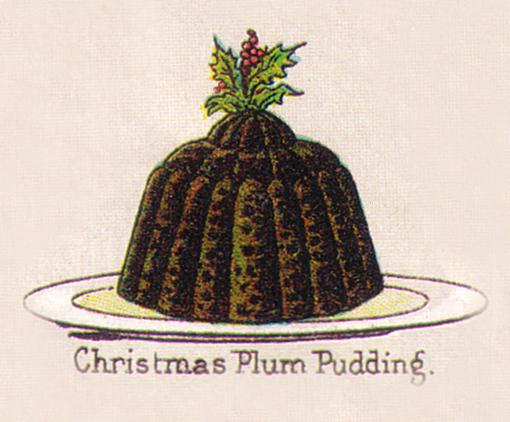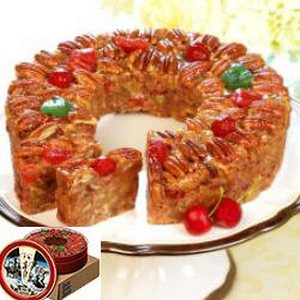I recently read the delightful Regency-era Christmas novel The Mischief of the Mistletoe, by Lauren Willig. Our hero Reginald “Turnip” Fitzhugh and heroine Arabella Dempsey are brought together by a Christmas pudding! Yep. A very creative ice-breaker to introduce and spark a romance, right?
 In 1803, Arabella is an instructor at Miss Climpson’s Select Seminary for Young Ladies in Bath, where “Turnip’s” sister Sally is a pupil. He is delivering her Christmas hamper to her and she in turn gives him a small muslin-wrapped and beribboned Christmas pudding which he proceeds to drop after barreling into to our heroine in the making in the hallway of the school. After profusely apologizing, he bounds out the door with Arabella in pursuit in an attempt to return the pudding to him:
In 1803, Arabella is an instructor at Miss Climpson’s Select Seminary for Young Ladies in Bath, where “Turnip’s” sister Sally is a pupil. He is delivering her Christmas hamper to her and she in turn gives him a small muslin-wrapped and beribboned Christmas pudding which he proceeds to drop after barreling into to our heroine in the making in the hallway of the school. After profusely apologizing, he bounds out the door with Arabella in pursuit in an attempt to return the pudding to him:
“Mr. Fitzhugh?” she called after him, holding the small, muslin-wrapped parcel aloft. “Mr. Fitzhugh! You forgot your pudding!”
Blast. He didn’t seem to have heard her. Lifting her skirts, Arabella hurried down the short flight of steps. Mr. Fitzhugh, his legs longer that hers, was already some way down the street, making for a very flashy phaeton driven by a team of matched bays.
“Mr. Fitzhugh!” she called, waving the pudding in the air, when the second man in one day knocked the breath out of her by taking a flying leap at the pudding she held in her hand.
It must have been pure stubbornness that caused her to keep her grip, but as the man tugged, Arabella found herself tugging back. Harder.
“I need that pudding!” her growled. “Give it over.”
“No!” gasped Arabella, clinging to the muslin wrapper with all her might. People couldn’t just go about taking other people’s puddings. It was positively un-British.
Indeed! “Turnip” comes to her rescue, fending off her assailant and hauling her off the ground for a second time in a day. The Christmas pudding is slightly askew from its original round shape, but what puzzles her most is a piece of paper attached to it written in French. Is it a cryptic message? A clue? A joke? It is this mystery that draws them together and the catalyst to their adventure and eventual romance.
If you’d like to find out how it all turns out for Turnip and Arabella – today is the last day to enter a drawing for two free copies of The Mischief of the Mistletoe, by Lauren Willig. Contest details can be found here, or leave a comment in this post telling me your Christmas pudding stories!
Making a Christmas pudding is quite a lengthy process involving a long list of ingredients. Here is a description of the boiling in a large “copper” during Victorian times.
A large cylindrical metal (often copper) container with a capacity of between 20 – 40 gallons (73-145 litres), sometimes encased in brick, under which a fire could be lit to heat the contents. Apart from the preparation of workhouse gruel, coppers were used for washing clothes and for heating large quantities of water. Since the copper was the largest container in the house it was also used at Christmas for boiling the Christmas pudding which tied inside a cloth, was immersed in the hot water. Charles Dickens World
The Christmas pudding has been a traditional treat in England for centuries. For those of us who did not grow up with it as a holiday season staple, here is a very brief history of the Christmas pudding from The English Tea Store, one of my favorite online retailers for those Anglophiles, like myself, who live thousands of miles away from the mother England!
Christmas pudding, also known as plum pudding (because of the abundance of prunes), originated in England. It is traditionally made five weeks before Christmas, on or after the Sunday before Advent. That day was often deemed “Stir-up Sunday,” and each family member or child in the household gave the pudding a stir and made a wish.
The rich and heavy pudding is boiled or steamed, made of a heavy mixture of fresh or dried fruit, nuts and sometimes suet, a raw beef or mutton fat. Vegetarian suet may also be used for a lighter taste. The pudding is very dark, almost black, and is saturated with brandy, dark beer, or other alcohols. The puddings used to be boiled in a “pudding cloth,” but today they are usually made in basins.
Many households stirred silver coins (for wealth), tiny wishbones (for good luck), a silver thimble (for thrift), a ring (for marriage), or an anchor (for safe harbor) into the mixture, and when served, whoever got the lucky serving, would be able to keep the charm. When silver coins were not as readily available, the practice ended because people feared putting alloy coins in their pudding. Today small token coins and other objects are made just for this use.
After the pudding has been steamed, it is kept in a cool dry place for several weeks or longer. It will need steamed for a few more hours on the day it is served. There are different ways Christmas pudding is served. Some decorate it with a spray of holly, douse it in brandy or set it on fire. Many families present the pudding in the dark or bring it to the table ceremoniously, where it is met with a round of applause.
Christmas pudding is eaten with brandy butter, rum butter, hard sauce, cream, custard or with a caster sugar. Families sometimes save one pudding for another holiday, like Easter, or even the next Christmas. Many argue that this takes away from the flavor, but that a good pudding will keep that long.
Recipes for plum puddings appear mainly, if not entirely, in the seventeenth century and later. It was not until the 1830s that the cannon-ball of flour, fruits, suet, sugar and spices, all topped with holly, made a definite appearance, becoming more and more associated with Christmas. It appears that Eliza Acton was the first to refer to it as ‘Christmas Pudding’ in her cookbook.
From childhood, my earliest Christmas food memories included a fruitcake that arrived every year by mail from my Great Aunt Margaret and Uncle Palmer. It came from the famous Collin Street Bakery in Corsicana, Texas. Highly anticipated and greatly appreciated in our family, I have never understood the ongoing jokes about their being only one fruitcake in the world that keeps being mailed away to relatives every year and never eaten. Not in my family!
So what’s the difference between an English Christmas pudding and an American fruitcake? They do contain many of the same ingredients: dried or candied fruits, nuts, and sometimes, wait for it… liquor and are both made weeks before eaten so the flavors can meld and the liquor can intoxicate the cake. From what I have gleaned over the years of taste testing, the difference between them is technique. The traditional English Christmas pudding is steamed and is very round in shape. I have read it described as a cannon ball! They are so moist that with the final addition of liquor on top, they can be dramatically flambéed (set on fire) and then brought flaming to the table with much pomp and ceremony, whereas, the American fruitcake is baked in round fancy cake or oblong loaf pans and the liquor is brushed on over weeks so it soaks in gradually. It is then sliced which reveals the glass window effect of the colorful candied fruits. In the gastronomical world, the American fruitcake is definitely the kissing cousin of the English Christmas pudding, though the Brits might disagree. We mustn’t dispute. They do have a few thousand years of Christmas traditions on us.
I love fruitcake so much that for years I searched for and taste tasted dozens of recipes. I think I have found the perfect combination of tart fruit, sweet sugar, rich butter, crunchy nuts and fragrant liquor to “set me up forever.” The secret to my ultimate fruitcake is that I use dried golden fruits like apricots, pears, peaches, pineapple, papaya, golden raisins (no prunes or gooey candied fruits in my fruitcake, thank you very much) and soak them in really good quality bourbon for two weeks before baking the cake five weeks before you plan to eat it. It is a lot of work and very expensive – but, only the best things in life are!
PS. For all of you that are cringing over the thought of a sticky, gooey and overly sweet fruitcake brick that your Great Aunt Winifred sends every holiday season, I have good news. You can re-gift it to Cousin Harold in Poughkeepsie who you have not seen in twenty years, and order one of the many incredibly delectable varieties offered from Collin Street Bakery instead. They are worlds away from that bad-rap fruitcake that is circumnavigating the globe at this very moment. Or, you can sweet talk me into sharing my super-secret recipe and make one for yourself. I promise, it will not be around long enough to necessitate re-gifting.
Merry Christmas & Happy Holidays to all my readers. Now, go forth and eat your Christmas puddings and fruitcakes as more enlightened connoisseurs.
Cheers, Laurel Ann
- Christmas Pudding at Jane Austen’s World
- Christmas Pudding at Jane Austen Centre Online Magazine
- Christmas Pudding recipe from Making Life Delicious
- Traditional Christmas Plum Pudding Recipes from Mrs. Beeton
© 2010 Laurel Ann Nattress, Austenprose.com





Before retiring, I worked as a cataloger at a library in New England. The library’s director was from England. For our staff Christmas party each year, the director made a dessert that she said was a traditional Christmas “trifle” — at least it was a tradition within her family — it was flavored with rum. Very tasty.
LikeLike
Oh they all look good!
Happy holidays, Laurel Ann, and looking forward to more great Austen goodness in the new year :)
LikeLike
I made a plum pudding one year and it took a tremendous amount of effort and some of it stuck in the pan (which it why I advise buttered parchment lining for the pudding bowl). It tasted OK, but very heavy- I wasn’t sure if it was too heavy or not- I had nothing to compare it to!
LikeLike
I bought a pan for making Toffee Pudding. I’ll let you know how it goes.
LikeLike
I heartily agree with your assessment of the Collin Street Bakery. Their fruitcakes are divine.
LikeLike
Great minds think alike, Laurel Ann. Two Christmas Pudding posts? The topic can is rich in history. Have a fabulous Christmas.
LikeLike
Merry Christmas, Laurel Ann, and enjoy lots of Christmas pudding!
LikeLike
Merry Christmas dear!
Al the best things from heaven for you and your family!
ADriana
LikeLike
Thanks for the fun post. We had a Brit friend for Christmas last year and he brought a small Christmas Pudding and the sauce for us to have. He carried it in his hand luggage. It was delicious! I didn’t know about the holly and the dousing it with brandy, though. That sounds awesome!
LikeLike
From the UK side of the pond I can vouch for the deliciousness of both Christmas Pudding and Trifle. WE will be making our puddings a week this Sunday…..
LikeLike
Thank You for your lovely article and fine set of illustrations to help us to understand the wonders of Plum Pudding!
Rose
LikeLike